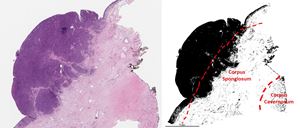CASE OF THE WEEK
2019-33 / SEPTEMBER 30
(CONTRIBUTOR: SOUNAK GUPTA)
An 82-year-old male with a prior history of rectal adenocarcinoma (treated surgically, followed by adjuvant chemo and radiation therapy) and upper tract urothelial disease (treated with a right sided nephroureterectomy) was recently diagnosed with penile cancer.
Quiz
The partial penectomy specimen revealed poorly differentiated squamous cell carcinoma of the glans penis. How would you stage this specimen?
a. pT1a
b. pT1b
c. pT2
d. pT3
1. c
1. pT2
Tumors involving the glans penis commonly spread horizontally to involve the coronal sulcus and foreskin. In this case, vertical spread to the corpus spongiosum was noted. Vertical spread is commonly seen with basaloid and sarcomatoid squamous cell carcinoma, with involvement of the urethra. Other routes of spread include the penile fascia. Positive surgical margins are often due to involvement of the urethra or penile fascia.
pT1a disease is defined as subepithelial connective tissue invasion without lymphovascular/perineural invasion and is not high-grade (grade 3 or sarcomatoid). In contrast, pT1b disease is defined as subepithelial connective tissue invasion with lymphovascular invasion and/or perineural invasion or is high-grade. pT2 tumors invade the corpus spongiosum with or without urethral invasion. pT3 tumors invade the corpora cavernosum including tunica albuginea and pT4 tumors invade adjacent structures (i.e. scrotum, prostate, pubic bone).
Amin MB, Edge SB, Greene FL, et al, eds. AJCC Cancer Staging Manual. 8th ed. New York, NY: Springer; 2017.
Velazquez EF, Soskin A, Bock A et al. Positive resection margins in partial penectomies: sites of involvement and proposal of local routes of spread of penile squamous cell carcinoma.
Am J Surg Pathol. 2004 Mar;28(3):384-9.
Sounak Gupta
Mayo Clinic, Rochester
Penis
Squamous cell carcinoma, Penis, Staging.




